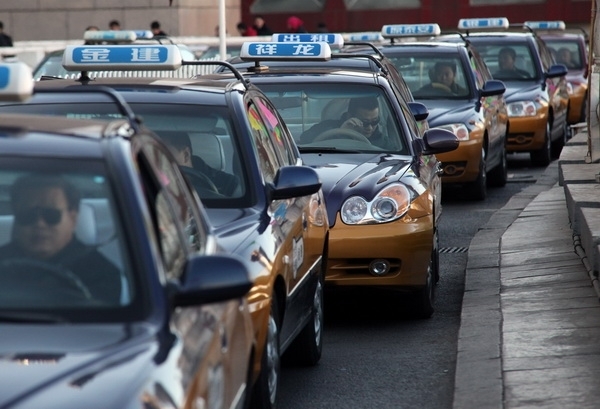


By Yu Han (余寒) and Zhang Xiangdong (张向东)
Issue 590, Oct 15, 2012
News, page 2
Translated by Zhu Na
Original article: [Chinese]
Six months ago, some people in Beijing started hailing taxis by shaking their phones.
A service called "Yaoyao Zhao Che" (摇摇招车), roughly translated as “Shake Shake Get a Taxi,” uses GPS and smartphone technology to connect passengers and taxis. Members who’ve downloaded the software and made a deposit simply shake their phone and receive a text message with the name of a taxi driver and brand of car. Within minutes, that car will arrive to pick them up.
The “Shake Shake Get a Taxi” software was developed by Beijing Juhe Zhongxin Information Technology Co., Ltd. (北京聚核众信) and currently has more than 10,000 members. It’s one of a few new business models struggling to capitalize on the huge gap between transportation supply and demand stemming from Beijing’s notoriously insufficient taxi fleet.
Wang Weijian (王炜建), founder of Juhe Zhongxin, said that in March the company rented 20 cars in order to test the “Shake Shake Get a Taxi” software. At the time, the service actually cost less than flagging down a normal taxi. But of those 20 cars, three were picked up by Beijing transportation authorities for operating as illegal taxis.
Wang thinks these test cars were stopped mainly because they were too similar to traditional taxis in terms of car model and price, which made them competitors. Now Wang has stopped using rental cars and has starting promoting the “Shake Shake Get a Taxi” application among official taxi drivers.
“When we were initially testing this system, many taxi companies didn’t understand it and were unwilling to work with us,” Wang said. “So our only choice was to rent some cars to test the software. Now, after a few months of testing, the software is mature and we can present it to taxi drivers.”
The company takes a small fee from members each time they order a cab through the service, but passengers only pay the driver what’s on the meter. So far, there are already about 1,000 taxi drivers using this free software. Wang Weijian aims to sign up at least 10,000 drivers by the beginning of 2013.
A team leader surnamed Hu with Beijing Tiancheng (天成)Taxi Company just shook his head when asked about “Shake Shake Get a Taxi.” He thinks that for taxi companies, the system is unprofitable.
Wang Weijian admitted that the lack of tangible profits to hand over to the taxi drivers and companies is the main challenge in promoting the software.
“The taxi companies may not make any direct profit each time they use the system,” Wang said. “But it is profitable in the long term. It can help drivers improve efficiency and increase their income. When drivers’ income increases, the money they hand in to the taxi company will be stable.”
However, for investors, actual operation is the most profitable market related to taxis. Zhou Hang (周航) started his Yidao Yongche (易到用车) company in May 2010 offering taxi services to customers through advance reservation. Currently, it’s China’s most successful car reservation platform with hundreds of thousands of members.
Zhou says that he avoids competing with traditional taxis by using mostly middle and high-end cars. “If we use a bunch of cheaper cars to compete with taxis, then we’ll court our own ruin,” he said.
Beijing’s population of over 20 million people is currently served by 66,000 taxis – the same number operating on the streets 10 years ago. According to Beijing’s 12th Five-Year Transportation Development and Construction Plan, Beijing will continue to control the total number of taxis.
In areas like Wangjing, the Beijing Zoo and other big transportation hubs, there are often long lines of illegal taxis. In the suburban counties where few official taxis venture, there are even more.
According to the most recent official survey, there were 72,000 illegal taxis in Beijing in 2004. Some taxi industry insiders estimated that that number probably exceeds 100,000 now. It’s a clear indication that the current official taxi fleet isn’t enough to meet market demands.
In spite of the huge demand though, matching legal taxis with customers is still inefficient. According to Li Xiaosong (李晓松), spokesperson for the Beijing Municipal Transportation Commission, an average taxi in the city drives about 400 kilometers per day. But for 30 to 40 percent of that distance, the taxi doesn’t have any passengers.
Guo Yushan (郭玉闪), founder and director of the Transition on Socio-Economic Consultants Co. Ltd, says that the emergence of information platforms like “Shake Shake Get a Taxi” will improve transportation efficiency. But car reservation services like Yidao Yongche are truly opening another market.
The car reservation business model isn’t yet recognized in law though, so it remains a legal gray area.
Hopeful entrants to the taxi market have appealed to government authorities to relax restrictions on taxis, but so far, they’ve received no reply.
Zhou Hang hopes the multitude of obstacles in the taxi industry will be relaxed one day. But until then, new business models like his waiting to make their move and grab a bigger slice of the taxi industry can only wait.

